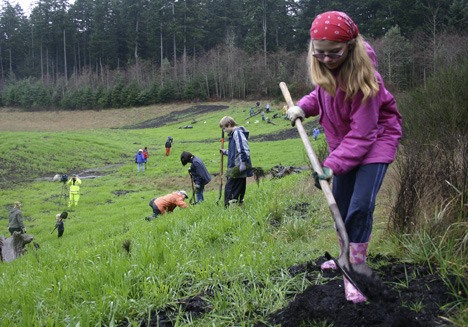Jeffrey Parrish was clear about why he joined dozens of other Islanders on a chilly winter morning last week to help plant some 1,000 trees at the so-called “borrow pit” next to the Vashon Transfer Station.
“I think it’s good for the environment and is a worthy cause,” the 11-year-old said matter-of-factly. Plus, he added, it gave him an excuse to be out in the mud. “You find something cool in every hole, like bugs or salamanders, and that’s really fun.”
Parrish, who was there with his mother and two younger brothers, was not the only one who seemed to relish the spade-work. Nearly 50 Islanders turned out on Saturday — parents with children, committed ecologists and newcomers — to help plant spindly Douglas firs, Western cedars, big-leaf maples and white pines, all part of a grand experiment to measure the role that soil reclamation and tree growth can play in offsetting climate change.
And even the elementary-aged children among them were able to utter the words “carbon sequestration” without missing a beat.
“Someone came to our class and talked about bio-solids and carbon sequestration,” said Selah Bellscheidt, 10. “I thought it would be really cool to help.”
The work party marked the second phase in Vashon’s “Carbon Project,” a collaboration between King County and the University of Washington to see if large quantities of nutrient-rich compost along the shoulders of a five-acre pit of degraded land can transform it into what good soil for centuries has provided: a repository for carbon.
The goal is to offset the predicted rise in greenhouse gas by storing or sequestering carbon — in other words, taking it out of the atmosphere and putting it back into the soil column.
Last fall, researchers completed the first phase, depositing yards and yards of different kinds of compost on the 16 study plots that line the borrow pit, said Bob Fuerstenberg, a senior ecologist in the county’s Department of Natural Resources and Parks.
“We’re now planting a selection of native plants to measure how well they grow in the compost,” he said.
Those trees, he said, will pull carbon out of the air. And over time, he said, the borrow pit — a patch of land where much of the soil was “borrowed” to place over the neighboring landfill — will host good, healthy, carbon-rich soil.
Once researchers know which compost mixes are the best, he added, they’ll look for other places in the county — from old pastures to public forestlands — in need of serious soil remediation.
“That’ll give us a chance to test the mix in a real-life situation,” he said.
On Saturday, spirits seemed high as Islanders worked — even though there was a chill in the air and mud on the ground. Muffins from Bob’s Bakery, coffee and hot cocoa were on hand, next to large displays describing the way healthy soils can help keep our atmosphere in balance.
Christie True, director of the county’s Wastewater Treatment Division and a Vashon resident, was among those hefting a shovel on Saturday. Looking out over the scene — dozens of Islanders in raincoats and muckboots making their way across the borrow pit — she said she was thrilled to see the role that treated waste is beginning to play in the county’s efforts to address climate change.
The county has what she called several waste-to-resource projects, which are under way in other parts of the region — but nothing that so directly addresses the issue of carbon sequestration, she said.
“I’m happy to be here,” she added. “This is my backyard. … To see this all coming together on Vashon is exciting to me, both personally and professionally.”



